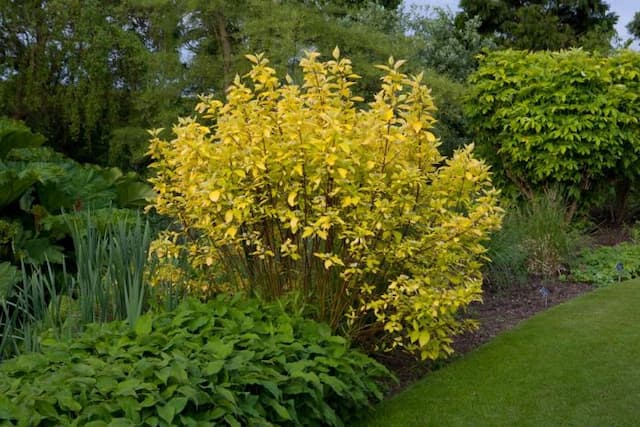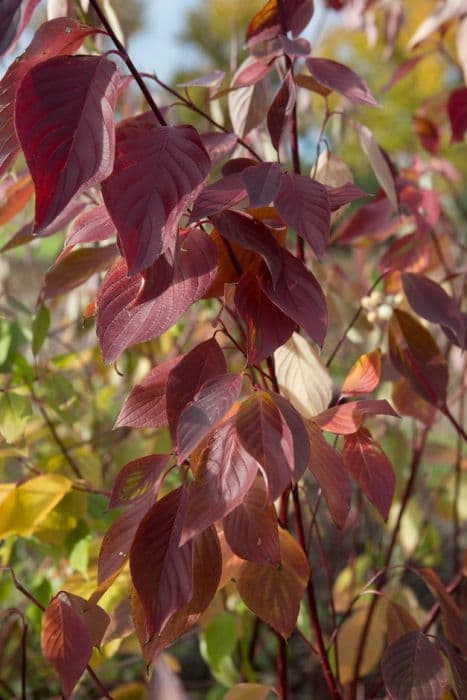Kousa 'Gold Star' Cornus kousa 'Gold Star' (v)











ABOUT
'Gold Star' forms a spreading shrub to about 2.5m. Mid- to dark green leaves have a bold, yellow, central, yellow splash, and turn red with purple margins in autumn. Small, white flower clusters appear in early summer surrounded by showy bracts, opening white then turning pink, and followed by red, strawberry-like fruit
About this plant
 Names
NamesSynonyms
Gold Star Kousa Dogwood, Gold Star Korean Dogwood, Gold Star Chinese Dogwood, Gold Star Japanese Dogwood.
Common names
Cornus kousa 'Gold Star'
 Characteristics
CharacteristicsLife cycle
Perennials
Foliage type
Deciduous
Color of leaves
Variegated
Flower color
White
Height
15-20 feet (4.5-6 meters)
Spread
15-20 feet (4.5-6 meters)
Plant type
Tree
Hardiness zones
5-8
Native area
Asia
Benefits
 General Benefits
General Benefits- Ornamental Value: Adds aesthetic appeal to landscapes with its striking variegated foliage and star-shaped flowers.
- Seasonal Interest: Offers year-round interest with flowers in late spring, red fruits in summer, and colorful foliage in the fall.
- Drought Tolerance: Once established, it requires minimal watering, making it suitable for xeriscaping.
- Wildlife Attraction: Produces berries that are a food source for birds and other wildlife.
- Low Maintenance: It is relatively easy to care for, requiring little pruning or special treatment.
- Cold Hardy: Can withstand cold temperatures, making it suitable for a variety of climates.
- Pest Resistance: Generally resistant to many pests, reducing the need for chemical treatments.
- Shade Tolerance: Can grow in partial shade, providing flexibility in garden design.
 Medical Properties
Medical Properties- This plant is not used for medical purposes.
 Air-purifying Qualities
Air-purifying QualitiesThis plant is not specifically known for air purifying qualities.
 Other Uses
Other Uses- Craft Material: The wood of Cornus kousa can be used in small craft projects or for carving due to its fine grain and hardness.
- Photography Subject: The tree's striking blossoms and unique fruits can be excellent subjects for photographers, especially during the spring bloom.
- Ink Production: The fruit of the Cornus kousa, when ripe, can be used to create natural inks for artwork or fabric dyeing.
- Culinary Garnish: The tree's small red fruits, while not commonly consumed in some regions, might be used as an ornamental garnish for desserts and specialty dishes.
- Flower Arrangements: Branches of Cornus kousa 'Gold Star' can be used in cut flower arrangements for their aesthetic appeal and longevity.
- Wildlife Shelter: This variety of dogwood can contribute to creating a wildlife-friendly garden by offering shelter and food for birds and bees.
- Educational Tool: The plant can be used in educational settings to teach about botany, specifically regarding flowering plant reproduction and fruit types.
- Artistic Inspiration: Artists can be inspired by the structure and form of the Kousa dogwood for drawings, paintings, and sculptures.
- Bonsai: The Cornus kousa 'Gold Star' can be grown as a bonsai tree, offering an interesting and challenging plant for enthusiasts to sculpt and maintain.
- Cultural Events: This plant's blooms may play a role in cultural and local festivals celebrating the arrival of spring or floral beauty.
Interesting Facts
 Feng Shui
Feng ShuiThe Kousa Dogwood is not used in Feng Shui practice.
 Zodiac Sign Compitability
Zodiac Sign CompitabilityThe Kousa Dogwood is not used in astrology practice.
 Plant Symbolism
Plant Symbolism- Resilience – Cornus kousa, commonly known as Kousa Dogwood, is known for its resilience and ability to withstand various environmental conditions, symbolizing one’s ability to endure and persist through difficulties.
- Purity – With its striking, white, petal-like bracts that appear in spring, Kousa Dogwood is often associated with purity and innocence, reminiscent of the pristine beauty of its flowers.
- Love and Affection – The beautiful and delicate appearance of the Kousa Dogwood's flowers can symbolize love and affection, often planted in memory of loved ones or given as a gesture of endearment.
- Protection – In some cultures, Dogwood trees are thought to symbolize protection because they were commonly planted near homes to guard against adverse conditions and to provide shade and shelter.
- Renewal – The annual blooming cycle of the Kousa Dogwood, with its vibrant display that marks the arrival of spring, represents renewal, new beginnings, and the hope that comes with each new season.
 Water
WaterThe Kousa dogwood, including the 'Gold Star' variety, prefers consistently moist soil but does not tolerate standing water. Initially, after planting, water it deeply once a week to help establish roots. Once it's well-established, the Kousa dogwood typically needs about an inch of water per week, either from rainfall or manual watering. During hot, dry periods, additional watering may be necessary to prevent soil from drying out completely. It's best to water deeply and less frequently, rather than little and often, which encourages the roots to grow deeper and makes the plant more drought-resistant. An estimated 5 to 15 gallons of water should be provided per watering to ensure that it reaches the root zone effectively.
 Light
LightKousa dogwood thrives in a spot that receives full sun to partial shade. The ideal condition is dappled sunlight throughout the day or direct sun in the morning with light shade in the afternoon. Avoid placing it in full, intense afternoon sun in hotter climates, as it may stress the plant and lead to leaf scorch. It can also grow well under the filtered light of taller trees, which simulates its natural woodland habitat.
 Temperature
TemperatureKousa dogwood is hardy and can survive in temperatures ranging from approximately -10°F to 90°F. However, the ideal growing temperatures are between 60°F and 75°F. It's important to protect the plant from extreme heat or cold, as prolonged exposure to temperatures outside its tolerance range can stress the plant or cause damage.
 Pruning
PruningPrune the Kousa dogwood to maintain its shape and remove any damaged or crossed branches to encourage healthy growth and airflow. The best time for pruning is late winter or early spring before new growth appears. Typically, Kousa dogwoods require minimal pruning, and it's often sufficient to prune them every two to three years.
 Cleaning
CleaningAs needed
 Soil
SoilThe Kousa Dogwood 'Gold Star' thrives in a well-draining, fertile soil with a pH of 5.5 to 6.5. A balanced mix of loam, sand, and organic compost or pine bark is ideal, providing adequate nutrients and moisture retention.
 Repotting
RepottingKousa Dogwoods, being larger landscape plants, are not typically repotted. Instead, young trees may be transplanted to a larger space in the garden as they outgrow their current spot, generally every few years when they are still small.
 Humidity & Misting
Humidity & MistingKousa Dogwood 'Gold Star' prefers average outdoor humidity levels. It does not require specific humidity adjustments as it adapts well to the natural humidity found in its growing environment.
 Suitable locations
Suitable locationsIndoor
Not ideal for indoor growth; requires outdoor conditions.
Outdoor
Plant in partial sun, mulch well, water regularly, protect from extreme cold.
Hardiness zone
5-8 USDA
 Life cycle
Life cycleCornus kousa 'Gold Star', commonly known as the Kousa Dogwood, begins its life as a seed, which after stratification germinates in spring. The seedling stage follows, where the plant develops its first leaves and a strong root system. As it enters the vegetative stage, the Kousa Dogwood grows rapidly, forming a substantial stem and a branching structure. Upon reaching maturity, the plant produces characteristic flowers, often in late spring to early summer, which after pollination develop into berry-like fruits. After the reproductive stage, the tree enters a period of senescence over several years, where growth slows and it becomes less vigorous until eventually dying. Throughout its life, the Kousa Dogwood may also undergo periods of dormancy during colder months, shedding its leaves and conserving energy until the next growing season.
 Propogation
PropogationPropogation time
Late winter-early spring
Propogation: The Kousa dogwood 'Gold Star' is best propagated by semi-hardwood cuttings taken in late summer. This popular method involves selecting a healthy, non-flowering stem that has started to mature but still retains some flexibility. The cutting should be about 4 to 6 inches long and include at least two sets of leaves. The bottom set of leaves is removed, and the cut end is dipped in rooting hormone before being placed in a well-draining potting mix, such as a blend of peat and perlite. The pot should then be covered with a plastic bag or placed in a humid environment to maintain moisture without keeping the soil waterlogged. Roots typically develop after a few weeks, at which point the new Kousa dogwood plant can begin to acclimate to less humid conditions before eventually being planted out in the garden.

![Dogwood [Baton Rouge]](/_next/image?url=https%3A%2F%2Fplants-admin.emdemapps.com%2Fimages%2Fplants%2F%2Fimages%2F604b59cf0fefd.png&w=640&q=75)

![Dogwood [Ivory Halo]](/_next/image?url=https%3A%2F%2Fplants-admin.emdemapps.com%2Fimages%2Fplants%2F%2Fimages%2F604b535cbcb9a.png&w=640&q=75)





![Dogwood [Venus]](/_next/image?url=https%3A%2F%2Fplants-admin.emdemapps.com%2Fimages%2Fplants%2F%2Fimages%2F604b58a531da1.png&w=640&q=75)